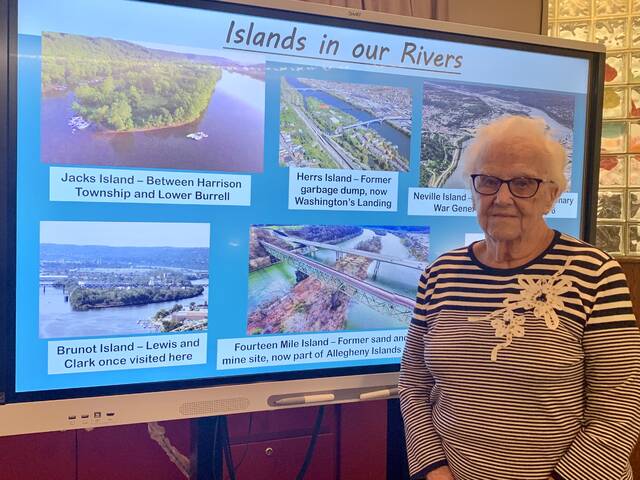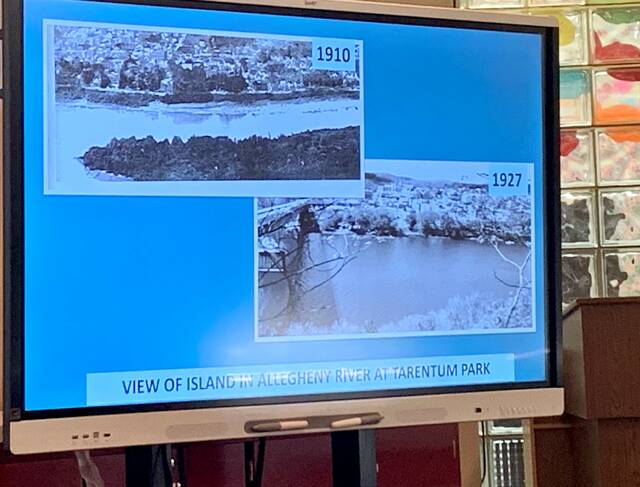Harrison library reveals ‘Secrets of the Allegheny River,’ including long-popular Jack's Island
Growing up in 1940s Natrona, Mary Ann Debor didn’t have to look far for a perfect riverfront getaway.
Her family was among a dozen who built wooden cabins on Jack’s Island, an idyllic retreat plopped in the middle of the Allegheny River between Harrison and Lower Burrell.
“We had a place called ‘Camp Paradise,’ and we really thought it was,” said Debor, who recalled long summer days spent splashing in the river and playing kickball on the shore.
The island was accessible from Natrona by rowboat.
“We didn’t have running water or electricity, but we thought it was wonderful,” she said.
Debor was one of 15 audience members at the Community Library of Allegheny Valley for Tuesday’s presentation of “Who Knew: Secrets in Our Rivers.” The program is offered monthly and covers nostalgic topics that appeal to longtime residents and those curious about local history. Past sessions have included Isaly’s, PPG and bridges.
Arnold resident Susan Lutman attends almost every workshop. Lutman grew up in Tarentum and is fascinated by local folklore and history, she said.
Tuesday’s presentation sparked her interest for its focus on the Allegheny River and its evolution. The discussion included Herr’s Island, a former stockyard beneath Pittsburgh’s 31st Street Bridge, where Lutman believes her parents might have met.
Librarian Kathy Bollinger has hosted the program since 2014 and has rarely recycled a topic. She said people are increasingly interested in learning the tidbits that make up Alle- Kiski Valley traditions and tales.
Bollinger said Jack’s Island is one of many that used to dot the Allegheny River. Some have eroded, and some were dredged away.
That particular piece of land was purchased by J.K. Davison Sand & Gravel, which dug away at the large piece of land across from Dreshar Stadium for its sand, she said.
Likewise, a sandbar purchased in 1829 by Henry Brackenridge also is mostly gone. Dubbed Tarentum Island, it sat near the mouth of Bull Creek.
On a dry, hot day, you can still see parts of it, Bollinger told the audience.
Downriver, closer to the former Springdale power plant, the 633,000-square-foot Puckety Island remains. It was used heavily in the 1910s but deserted by 1927.
Bollinger said many people used to ferry to the islands from the Craigdell Station in Lower Burrell and then walk to the Tarentum side of the riverbanks on a boardwalk.
“Before the dams, the river was shallow enough that people could cross it in wagons,” Bollinger said.
When Lock and Dam No. 4 was constructed in Natrona in 1927, it cost $1.7 million. It enabled swifter navigation for industries to move their products but drastically changed recreation in the water, she said.
Some islands withstood the test of time, such as Neville Island near Pittsburgh, which was purchased by a Revolutionary War general, and 14-Mile Island near Harmar, above which the Pennsylvania Turnpike crosses.
During the program, Bollinger divulged other trivia, such as the fact that Colfax Power Station, which operated from 1919 to 1947, was once the biggest user of river water in the country.
“It pumped 14 million gallons a day from the subterranean rivers for use in boilers and generators,” she said.
Bollinger also talked about the underwater tunnel at the West Penn Power Plant in Springdale that transported coal from Logans Ferry for nearly five decades.
Debor, 88, recalled many of the spots in Bollinger’s presentation. She said the Allegheny River was a focal point for many Natrona families like hers, who lived in the company homes near Penn Salt.
To children then, the 2-mile walk up the railroad track to Karns was nothing to complain about, Debor said.
“When you got there, you’d yell, ‘Over!’ and someone would row over and get you,” she said. “There were goats on the island to keep the grass cut and my mom even milked them. We bathed in the river with Ivory soap, and at night the families would form a band and play the washboard, jugs and spoons.
“I wish kids today could have memories like that.”
Tawnya Panizzi is a TribLive reporter. She joined the Trib in 1997. She can be reached at tpanizzi@triblive.com.
Remove the ads from your TribLIVE reading experience but still support the journalists who create the content with TribLIVE Ad-Free.


